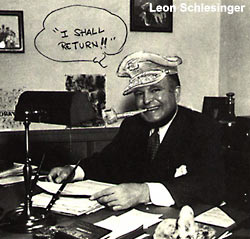

Animation’s greatest executives
 It’s time for my monthly “things could-be-so-much-better” post. When I complain about the state of the industry, friends frequently tell me, “But look at how much better animation is today than it was twenty years ago…” True. But shouldn’t we be asking, “How much better could it be?” Look at the talent working in the business today. It’s a solid bet that there are more talented individuals working in animation today than at anytime since the 1950s. And yet, you’d never know that from looking at the product that makes it into theaters and onto television. Granted, it may be a step or two above THE HARLEM GLOBETROTTERS MEET THE FONZ or whatever the hell they were doing back in the 70s and 80s, but since when have Filmation and Hanna-Barbera been the yardstick of quality by which all other animation is judged.
It’s time for my monthly “things could-be-so-much-better” post. When I complain about the state of the industry, friends frequently tell me, “But look at how much better animation is today than it was twenty years ago…” True. But shouldn’t we be asking, “How much better could it be?” Look at the talent working in the business today. It’s a solid bet that there are more talented individuals working in animation today than at anytime since the 1950s. And yet, you’d never know that from looking at the product that makes it into theaters and onto television. Granted, it may be a step or two above THE HARLEM GLOBETROTTERS MEET THE FONZ or whatever the hell they were doing back in the 70s and 80s, but since when have Filmation and Hanna-Barbera been the yardstick of quality by which all other animation is judged.
So how much better could animation be? That question could be answered with more questions, like, Why doesn’t Michel Gagné have a show on the air? Why doesn’t Aaron Springer have his own show? How did James Baxter work at DreamWorks and all we ended up with was SPIRIT? The list goes on forever. Fortunately artists are smarter today than they’ve ever been. If the industry can’t accommodate them, they create independently, just as all the artists I mentioned have done. But why not examine the source of the problem. Why is it impossible for talented artists to find support within their chosen industry?
As usual, we can learn from the past. Let’s look at how some great animation executives of the past supported their talent — executives with last names like Schlesinger, Quimby and Selzer. These guys get a bum wrap in history books, but many of the greatest cartoons were made under their watch. What was their secret? What did they do that today’s executives don’t? Here’s director Tex Avery speaking about his experience with executive Leon Schlesinger at Warners:
“We worked every night — Jones, Clampett, and I were all young and full of ambition. My gosh, nothing stopped us! We encouraged each other, and we really had a good ball rolling. I guess Schlesinger saw the light; he said, ‘Well, I’ll take you boys away from the main plant.’ He put us in our own little shack over on the [Warner Bros.] Sunset lot, completely separated from the Schlesinger studio, in some old dressing room or toilet or something, a little cottage sort of thing. We called it Termite Terrace. And he was smart; he didn’t disturb us. We were all alone out there, and he knew nothing of what went on.”
The key isn’t to be completely oblivious to your studio’s operations. Schlesinger recognized talent. He had the good sense of hiring Avery away from Walter Lantz. And then he built a team, partnering Avery with like-minded individuals such as Chuck Jones and Bob Clampett. But then he did one more thing that today’s execs don’t — he trusted his talent. He created the environment in which his talent could flourish; Avery, Clampett and Jones were willing to work all night because they knew their work wouldn’t be trashed the following morning by Schlesinger.
Sure, Leon may have spent his weekday afternoons playing eighteen holes or chasing the pretty secretaries around his yacht, but he’d already laid the foundation for the creation of great animated entertainment. The results of Schlesinger’s business acumen? Bugs Bunny, Daffy Duck and some of the finest cartoons ever made. Executives today are afraid to invest that amount of control and trust into their artists. They insist on putting their “personal stamp” on everything that gets produced, and they do so at the expense of stifling the artist’s creativity. It’s not that the industry has lost its ability to produce great cartoons — rather the powers-in-charge have gone to extreme lengths to ensure that the conditions which would allow for the creation of quality animation don’t exist. The solution? Today’s animation executives need to spend more time aboard their yachts.
Update (9:34am): Mark Evanier has a nice response to this piece at his always enjoyable blog NewsFromME.com. He agrees with the premise of these comments, but isn’t quite so head-over-heels for Schlesinger.

